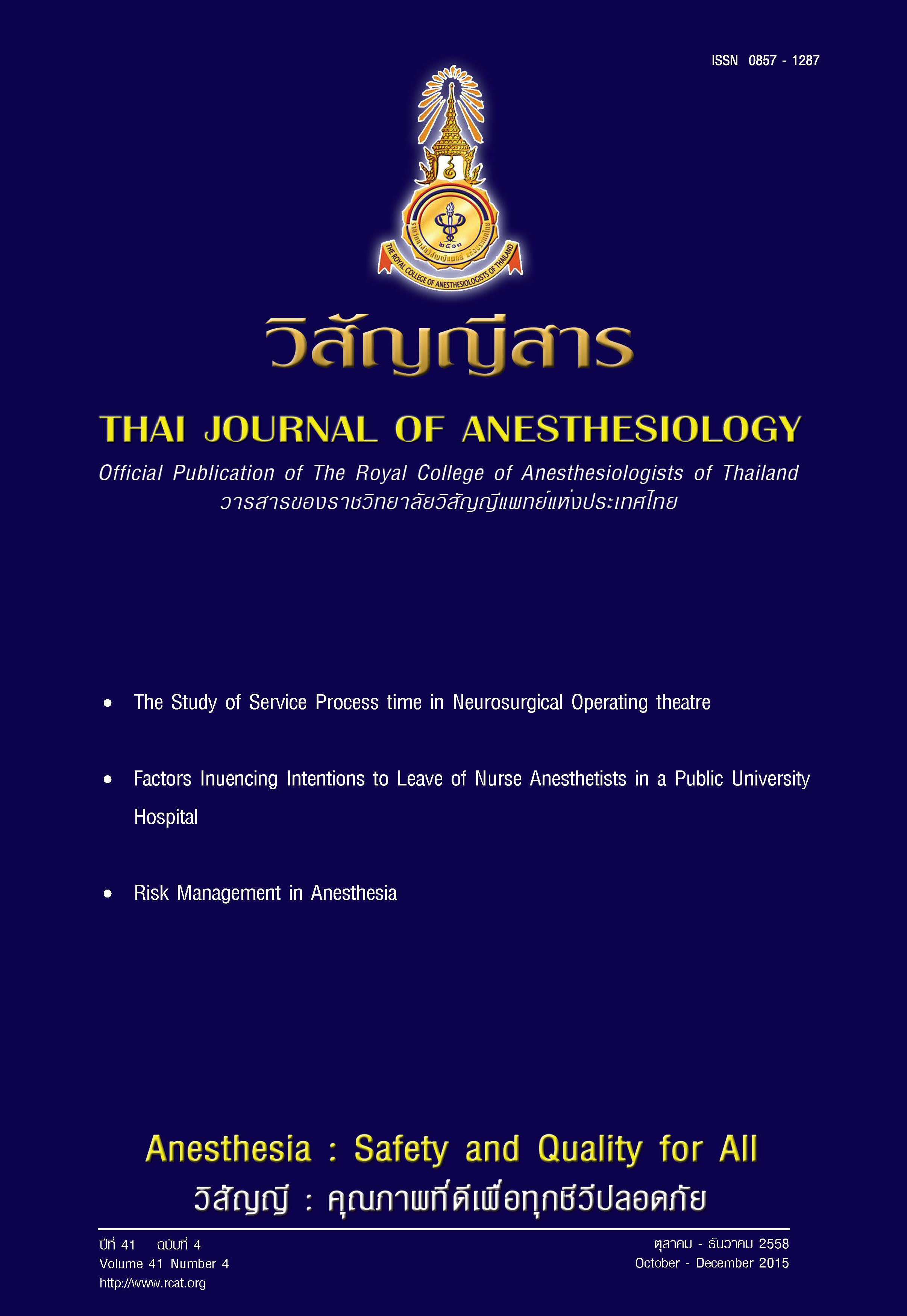Effect of intraoperative gastric decompression by orogastric tube to reduce the incidence of immediate postoperative nausea and vomiting in adult elective breast surgical patients
Main Article Content
Abstract
Background: Postoperative nausea and vomiting (PONV) continues to be a significant problem in patient undergoing breast surgery. Routine use of nasogastric (NG) tube or orogastric (OG) tube has been suggested to prevent PONV despite conflicting data.
Objective: To determine the efficacy of intraoperative OG tube insertion for gastric decompression in reducing early PONV incidence in breast surgery.
Methods: Our study was a prospective, randomized, double-blind trial. One hundred and thirty eight patients undergoing elective breast surgery in Srinagarind Hospital between October 2013 and September 2014 were enrolled into 2 groups. Group I received OG tube, while Group II did not receive OG tube after induction of anesthesia. Standard anesthetic technique, including PONV prophylactic drugs, and postoperative care were employed in all patients. PONV score, classified into grade 1 and 2, were recorded at 2- and 4-hour after the end of surgery. Incidence of grade 2 PONV at 2- and 4-hour and requirement for rescue antiemetic drugs in both groups were compared. P value < 0.05 was considered statistically significant.
Results: Demographic data and surgical characteristics were similar in both groups. Incidences of grade 2 PONV at 2- and 4-hour after the end of surgery were comparable low in both groups (P > 0.05). The requirements for rescue antiemetic drugs were also tiny and similar in both groups (P > 0.05).
Conclusions: Use of intraoperative OG tube for gastric decompression cannot reduce incidence of early PONV and decrease antiemetic consumption in patients undergoing breast surgery.
ผลของการลดความดันในกระเพาะอาหารโดยวิธีใส่สายสวนทาง ปากระหว่างผ่าตัดในการลดอัตราการเกิดภาวะคลื่นไส้และอาเจียน หลังผ่าตัดระยะแรกในผู้ป่วยที่มารับการผ่าตัดเต้านมแบบไม่รีบด่วน
บทนำ: ภาวะคลื่นไส้และอาเจียนหลังผ่าตัดถือเป็นปัญหาที่สำคัญในผู้ป่วยที่เข้ารับการผ่าตัดเต้านม แนวทางปฏิบัติที่ทำเป็นประจำคือการใส่สายสวนทางจมูกหรือปากเพื่อลดความดันในกระเพาะอาหารนั้นช่วย ลดอัตราการเกิดภาวะคลื่นไส้และอาเจียนหลังผ่าตัดได้แต่ยังไม่มีข้อมูลที่สรุปชัดเจน
วัตถุประสงค์: เพื่อศึกษาถึงประสิทธิภาพของการใส่สายสวนทางปากระหว่างผ่าตัดเพื่อลดความดันในกระเพาะอาหารในการลดอัตรา การเกิดภาวะคลื่นไส้และอาเจียนหลังผ่าตัดระยะแรก
วิธีการศึกษา: ผู้ป่วยจำนวน 138 คนที่มารับการผ่าตัด เต้านมแบบไม่เร่งด่วน ถูกแบ่งออกเป็นสองกลุ่ม กลุ่ม 1 ได้รับการใส่สายสวนทางปากหลังจากนำสลบเพื่อ ลดความดันในกระเพาะอาหาร และกลุ่ม 2 ไม่ได้รับการใส่สายสวนทางปาก โดยผู้ป่วยทั้งสองกลุ่มนั้นได้รับ ยาป้องกันคลื่นไส้อาเจียนตามมาตรฐานของภาควิชา บันทึกข้อมูลคะแนนการคลื่นไส้และอาเจียนหลังผ่าตัด เป็น 0, 1, 2, และ 3 และแบ่งระดับความรุนแรงของภาวะคลื่นไส้และอาเจียนเป็นระดับ 1 (คะแนน 0-1) และ 2 (คะแนน 2-3) ที่ 2 และ 4 ชั่วโมงหลังผ่าตัด รวมถึงจำนวนผู้ป่วยที่ต้องการยาแก้ไขภาวะคลื่นไส้และอาเจียน
ผลการศึกษา: อุบัติการณ์การเกิดภาวะคลื่นไส้และอาเจียนระดับ 2 ของทั้ง 2 กลุ่ม ที่ 2 ชั่วโมงเท่ากับร้อยละ 1.4 และ 1.4 ขณะที่ 4 ชั่วโมงหลังผ่าตัด พบร้อยละ 4.3 และ 7.2 ซึ่งเกิดน้อยทั้งสองกลุ่มและไม่มีความแตกต่าง ทางสถิติ (P > 0.05) จำนวนผู้ป่วยที่ต้องการยาแก้ไขภาวะคลื่นไส้และอาเจียนก็ไม่มีความแตกต่างกันอย่าง มีนัยสำคัญทางสถิติทั้งสองกลุ่ม (P > 0.05)
สรุป: การใส่สายสวนทางปากในระหว่างผ่าตัดเพื่อลดความดัน ในกระเพาะอาหารไม่สามารถลดอัตราการเกิดภาวะคลื่นไส้และอาเจียน รวมถึงไม่ลดจำนวนผู้ป่วยที่ต้องการยา แก้ไขภาวะคลื่นไส้และอาเจียนหลังผ่าตัดระยะแรกในผู้ป่วยที่มารับการผ่าตัดเต้านม


